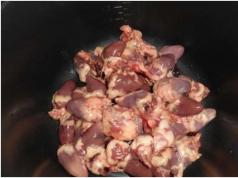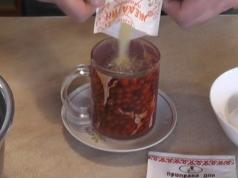Champagne is always served chilled. It's chilled, not frozen. In some restaurants, it is often served at a temperature of 3-4C, which is desirable only for bad sparkling wine: in this way it is possible to hide some of its flaws. Champagne, especially good champagne, will not reveal all its aromatic qualities at low temperatures. The optimum serving temperature for ordinary champagne is 7-9C, best brands: 9-12. Chill champagne in the refrigerator (but do not store it there) or, best of all, in a bucket of ice and water. In the second case, it is necessary that there is a little more water. If you do it the other way around or simply put ice on the bottle, the cooling will be too slow and incomplete. In order for it to be uniform, it is recommended to periodically turn the bottle in the bucket. How long to keep a bottle in a bucket? It depends on its initial temperature. It's one thing if you brought a bottle from the cellar with constant 14C, another if it was in a warm room. Here the best adviser is experience, but in any case, you should not keep the bottle in the bucket for too long: as a rule, the wine reaches the right temperature in 15-30 minutes. It must also be remembered that, firstly, bottles of large volumes require longer cooling; secondly, in a glass the wine warms up quickly (by 2-3 degrees), so it is advisable to cool the bottle just below the consumption temperature. And of course, if champagne is drunk slowly, after a while it is necessary to return the bottle to the bucket again. In a conventional refrigerator, champagne is cooled for 1.5-2 hours, but even here it all depends on its initial temperature. Freezers are, of course, excluded.
Champagne is poured two-thirds (usually in two doses) into tall narrow crystal glasses (flute), strictly functional, without any decorations, notches, color inserts, gold rims, etc.
Of course, the glasses must be perfectly clean and dry - otherwise the bouquet and gas bubbles will suffer. That is why it is extremely important to rinse the glasses thoroughly to completely remove the detergent from them, and then wipe dry with a clean towel or leave to dry upside down. However, in the second case, immediately before serving, it is advisable to wipe the glasses with an absolutely clean towel to remove dust and drips remaining from the water. Some experts recommend additionally rinsing glasses with distilled or mineral water with low salt content. Many people think that glasses should be washed only with warm water, without the use of detergents, and then allowed to dry without wiping. There is, perhaps, a reason for this, since even the cleanest towel can have some kind of smell and leave lint.
How to determine the quality of champagne? First of all, you need to study it visually. A good champagne should be completely clean and transparent, of a beautiful color, with a lively shine, light, openwork, pleasing to the eye foam, after settling of which its traces remain along the edges of the glass, the so-called necklace (cordon or collier). Sometimes, however, they say so about the chains of bubbles and their play on the surface of the wine. Bubbles, often compared to small pearls, are formed by microscopic irregularities at the bottom of the glass and should normally be very small and exactly the same in diameter. But one should not rush to conclusions: the quality of the bubbles should be judged no earlier than 30 seconds after filling the glass, when its temperature and the temperature of the champagne are equal (at first, the bubbles can be large and uneven). In no case should you pre-cool the glass (with ice or in the refrigerator): this will inevitably lead to the formation of moisture on its walls, which will adversely affect the quality of the champagne.
After examining the champagne (for tasters this phase is called the “eye”), it is sniffed (“nose”). A good champagne should have a complex, rich and delicate bouquet (harmonious combination of aromas), which may contain smells of flowers, fruits, berries, spices, dough, almonds, walnuts, licorice, vanilla, cocoa, butter, bread crumb, biscuit, minerals (oil, silicon), aromatic resins, honey, wax. Possible vegetable (wood, leaves, needles, juniper, eucalyptus, heather) and empyrematic smells (burnt, burnt, baked, dried - for example, roasted sunflower seeds, burnt wood, hay, straw). Yeast and alcohol odors are typical of not-so-good champagnes, although alcohol odors may be due to insufficient cooling of the drink. Too old or spoiled champagne can smell musty, rotten, mold, vinegar, sour milk, etc. Of course, chemical odors (phenol, acetone, iodine, sulfur) should not be characteristic of normal wine, by the way, yeast and alcohol also belong to this category.
The third phase of tasting is called "mouth". The taste of good champagne must first of all be balanced. In other words, none of the main components of wine (alcohol, sugar and acidity) should not prevail or be felt separately. Harmony, refinement and fullness of taste - these are the main indicators of good champagne.
And finally, aftertaste, or, as they say in France, duration in the mouth. The better the wine, the longer the aftertaste lasts. Unpleasant sensations in the mouth from bad or spoiled champagne, of course, cannot be called an aftertaste.
As mentioned above, champagne is a universal wine. However, its versatility is relative. Being a white natural wine (pink champagne, of course, has certain characteristics, but in terms of its properties it is still closer to white wine than to red), champagne does not go well with red meat, although some compromises are possible here, not to mention individual preferences.
Champagne, moreover, is an excellent aperitif, as the subtlety of its aroma and piquancy of taste are well prepared for a meal. The gastronomic recommendations brought to your attention, of course, cannot be considered either exhaustive or absolute. These are just some tips on the most typical combinations.
Cold and hot appetizers, seafood, soups - a simple brut with a high Chardonnay content or blank de blanks. Oysters, lobsters, scallops, foie gras, plum sorbet, vegetable salads, veal chop, baby spinach, goose, caviar pancakes, goose terrine, fried perch, fresh fig pie, lamb saddle with thyme, char, crabs, pike soufflé - white bruts of medium intensity.
fish pate, kulebyaka or aspic from fish, aspic from poultry, beef jelly - brut zero. Truffles - brut blank de noirs.
White meat (poultry), veal under cream sauce, terrine from thymus, wild strawberry, nectarines, game birds, lamb thigh, duck - pink brut. Monkfish medallions with grapefruit, game birds, hare, venison, pheasant, smoked trout, perch with fennel, turbot fish, flounder, clams, basil prawns, baked salmon, crayfish, young goat cheese, sole fillet in flour , langoustine salad, veal, mullet, sautéed lobster, biscuit, baked apple, hazel grouse, caviar, halibut fillet, extragone veal fillet, mussels in saffron sauce - high-class blanc de blancs.
Roasted quail with herbs, pike, perch, goiter glands of a calf with morels in dough, gratin scallops, leg of lamb with baby peas and artichokes, sea urchin, vol-au-vent ( layered cake) with cockscomb sauce, sea fish, foie gras, baked perch, spiny lobster - the best white bruts.
Meat carpaccio, cold game bird pie, cold partridge, black grouse or woodcock, some Chinese and indian cuisine- the best vintage bruts, white and pink.
tender fish, poultry, white meat, vegetables in a creamy sauce - rich millesimal blank de noirs. Goat cheese, under dark dishes, moderately spicy sauces- millesimal white and pink.
Sorbet, not-so-sweet desserts, biscuits - unmistakable brut, light rose and semi-sweet champagne. Biscuits and biscuits - semi-sweet and sweet champagne.
Thrushes with sage, sautéed lamb cutlet, shrimps, eel, fish salad, sushi, smoked fish, mango, cod with potatoes - white millesime brut. Crepe suzette, meringue, millefeuille, soufflé - sweet champagne.
Champagne glasses must meet two basic requirements: to maintain the prestige of champagne; allow to evaluate all the advantages of this wine (color, taste, aroma).
In all other respects, you are free to choose for yourself, but you should know a few simple rules:
Remember that the shape of the glass affects the "game" of champagne, the release of gas bubbles.
The more pointed the bottom of the glass, the more lively the foam will form in it.
In an absolutely clean smooth glass, bubbles do not form well, so some manufacturers cut an asterisk at the bottom of the glass. Detergents can negatively affect the foaming of champagne, so you should thoroughly rinse the glass and wipe it with a linen napkin.
For serving champagne, narrow oblong glasses are best suited, since in glasses in the form of a bowl the wine spreads, the foam does not hold, and the bouquet quickly
Dissipates.
Supply temperature
In most cases, champagne is served at 6-8°C (43-46°F). If possible, it is cooled in a bucket filled with a mixture of water and ice. To do this, you need to put a few handfuls of ice cubes on the bottom of the bucket, put a bottle in it, put it around with ice, to the top, and then pour cold water, almost to the brim.
It takes about 1 hour to cool champagne in a bucket to a temperature of 7 ° C, if before that it had a temperature of 20 ° C.
Don't forget to add water to the ice bucket!
If there is no water in the bucket, then the champagne will either get too cold or not cool enough, since the ice is not in contact with the entire surface of the bottle.
If you need to quickly cool the bottle, you can add a handful of salt and a glass of sparkling water to the bucket. But only use this when absolutely necessary.
If you do not have a bucket, place the bottle in the refrigerator for 2.5 - 3 hours.
But don't put champagne on the balcony, don't bury it in the snow, don't put it in the freezer, and don't immerse it in liquid nitrogen. Supercooled champagne is tasteless and devoid of bouquet.

Opening a bottle
Without removing the bottles from the bucket, you need to lift the wire knot and twist it counterclockwise, holding the cork with your other hand. To prevent the cork from flying out, you should hold it until you completely unwind the wire. Then remove the wire together with the foil.
When pulling out the cork, you need to firmly hold the protruding part of the cork with your hand, and slowly turn the bottle with your other hand. When you feel that the cork is starting to come out, press it with your hand to prevent it from flying out, and then remove the cork silently. After that, the neck should be wiped with a clean napkin and you can pour champagne into glasses.
To keep the champagne from overflowing, place a few ice cubes in each glass and swirl them around until the glass fogs up. Then discard the ice and pour the champagne. The glass is filled to half or two-thirds and topped up as needed.
.
Similar recipes:
- Festive, sophisticated, sophisticated, inspirational - Champagne is unlike any other wine. Shades of white, yellow or pink...
How to serve champagne correctly, this article is devoted to this. Before enjoying champagne, it must be properly stored, opened, drunk and served with appropriate snacks. Champagne is not only traditional drink on the New Year and Christmas.
(function(w, d, n, s, t) ( w[n] = w[n] || ; w[n].push(function() ( Ya.Context.AdvManager.render(( blockId: "R-A -466979-2", renderTo: "yandex_rtb_R-A-466979-2", async: true )); )); t = d.getElementsByTagName("script"); s = d.createElement("script"); s .type = "text/javascript"; s.src = "//an.yandex.ru/system/context.js"; s.async = true; t.parentNode.insertBefore(s, t); ))(this , this.document, "yandexContextAsyncCallbacks");
Sparkling wine is suitable for any occasion. An evening with friends, any family celebration, romantic dinner. For every moment you can choose your own champagne, the main thing is to serve it correctly.
How to serve champagne the right way

Like any noble wine, champagne should be properly stored before opening the coveted bottle.
At what temperature should champagne be stored?
Champagne should be stored at a temperature of 12-14 degrees Celsius, and it is better in a room with high humidity. The bottle must be placed on its side. This will keep the cork from drying out and preserve the drink better.
At what temperature should champagne be served?
Now it's time to open the bottle. It is necessary to observe some subtleties. Champagne should not be served too cold. The cold destroys the bubbles and leaves less flavor. The correct serving temperature for champagne is 9-11 degrees Celsius. At this temperature, the aroma of champagne is fully revealed, and ideal bubbles are formed. In one phrase, the secret of serving champagne can be expressed as follows:
Store it in a cool place and serve chilled.
Time to open a bottle of champagne
Opening a bottle of champagne can be a very dramatic and tense moment. It's better to do it right and not end up with a half-empty bottle, a soiled suit and a sticky puddle. First, you should never point the neck of a bottle at someone when opening it. The best way open the bottle is as follows:
- Place the bottle on a flat surface or press against the body at an angle of 45 *.
- Remove foil cover
- Unscrew and remove the metal mesh, while holding the cork with your hand so that it does not knock out ahead of time.
- Turn the bottle under the cork and wait until you hear the characteristic "sigh" of the cork, then calmly open the cork.
- Pour into glasses should not be in the center, but along the edge of the glass, being careful.
Watch the chef's video on how to perfectly open the champagne and pour it into the glass.
Using this technique, you will not hurt anyone, avoid losing champagne and get perfect foam and bubbles. After opening, champagne is best stored in a metal bucket with ice and water. This will keep its excellent qualities longer.
Serve the right glasses
A bottle of champagne is open and waiting for its finest hour. Time to pour champagne into glasses! There is subtlety here! Often champagne is poured into ordinary wine glasses. This is a classic mistake. Champagne, poured into ordinary glasses, looks good, but quickly loses all its properties. Glasses for ordinary wine are too wide for champagne, aroma and bubbles evaporate instantly. Champagne should be poured into champagne glasses!
It is better to purchase an inexpensive set of champagne glasses than to pour the drink into expensive glasses designed for red wine. The perfect champagne glass is shaped like a tulip. The glass is elongated, has an expansion in the middle and narrows at the top. This form retains the freshness, aroma of the drink longer and promotes the formation of bubbles.
Best Champagne Appetizers
Ever wondered when is the best time to serve champagne? Before, during lunch or after lunch? Although, it can be assumed that it depends on personal preference. It is believed that it is better to serve champagne before or during dinner. It is not recommended to serve champagne with dessert.
A sweet dessert is completely incompatible with champagne and can destroy the whole taste of sparkling wine. In addition, there may be stomach problems. If champagne is served before dinner, then cheese should be served as an appetizer. Various types of cheese and other savory snacks perfectly complement the sparkling taste of champagne.
If champagne is served during dinner, then the ideal snack is seafood, different kinds meat or butter Italian pasta with unsweetened vegetables and herbs. The holiday is over, but there is still half a bottle left. How to save the rest of the holiday?
Champagne will keep its properties for several days, provided that you choose the right cork and keep the bottle in the refrigerator. The more the bottle is filled, the longer the champagne will retain its properties. How to serve champagne is no longer big secret, it remains to wait for the holiday and bring all the tips to life.
I suggest watching a very funny video How not to open champagne!








